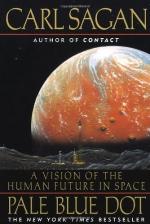
|
Introduction, Wanderers
1. What does Sagan suggest that cavemen were usually looking for when they wandered?
(a) Food.
(b) Mates.
(c) Shelter.
(d) New territory.
2. About how long does Sagan suggest that human beings have been "settled down"?
(a) 100,000 years.
(b) 1,000 years.
(c) 50,000 years.
(d) 10,000 years.
3. What means does Sagan suggest that humans use to represent and express their desire to wander?
(a) Stories and symbols.
(b) Colonization.
(c) Adventures.
(d) Trade.
4. What other medium was used to express the desire to wander, according to Sagan, as human civilization developed?
(a) Technology.
(b) Religion.
(c) Law.
(d) Ethics.
5. According to Sagan, which of the following was the most notable historical tool that humans used to explore the world?
(a) Roads.
(b) Compasses.
(c) The Wheel.
(d) Ships.
6. How many planets were known to ancient people?
(a) Four.
(b) Five.
(c) Three.
(d) Six.
7. What did ancient people notice about planets that set them apart from the stars?
(a) They grew closer from time to time.
(b) They had complex motions and were not fixed.
(c) They were much larger.
(d) They had unique colors.
(read all 180 Multiple Choice Questions and Answers)
|
This section contains 4,326 words (approx. 15 pages at 300 words per page) |

|




